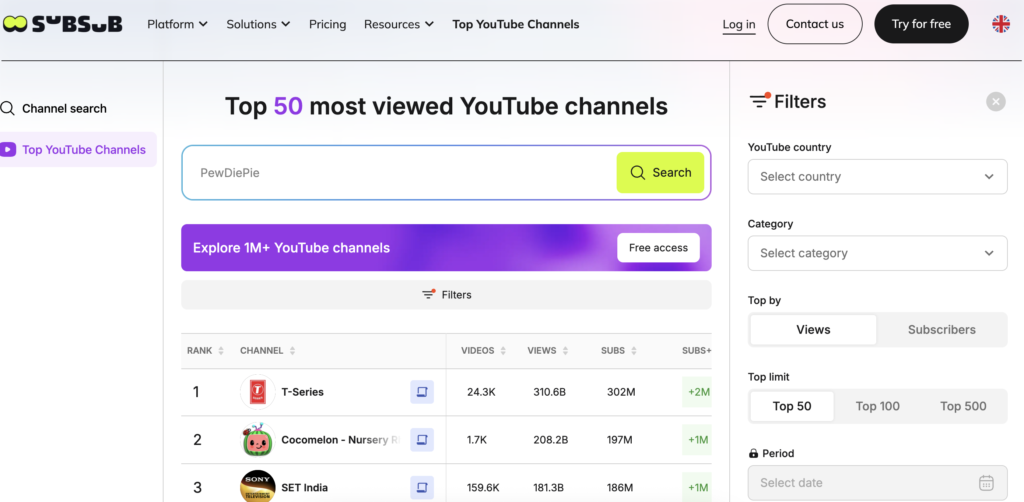YouTube has evolved far beyond being a video platform – it’s now one of the most powerful marketing engines for businesses and creators.
With over 2.7 billion monthly active users, it’s the second-largest search engine in the world, just behind Google.
But here’s the truth: simply uploading videos is no longer enough. Success on YouTube comes down to understanding your own data and benchmarking against industry trends to stay competitive.
In this article, I’ll walk you through:
- Which YouTube metrics matter most.
- How to turn analytics into growth actions.
- Why benchmarking against global YouTube trends is essential.
- Tools that simplify and accelerate your growth.
Whether you’re a marketer, business owner, or solo creator, these insights will help you unlock new opportunities for growth in 2025.
Why YouTube Analytics Is More Than Just Numbers
For many businesses, analytics feels like a checkbox: log in, look at views, maybe check subscribers, and move on. But the real power lies deeper.
Analytics can tell you:
- What resonates with your audience (topics, formats, video length).
- Where you lose viewers (down to the exact second).
- Which traffic sources actually drive growth (search, suggested, external).
- How engagement fuels business outcomes like leads, sales, or sign-ups.
This isn’t just reporting, but a real strategy fuel. Instead of guessing what works, you’re making data-driven choices that reduce wasted effort and amplify results.
YouTube Metrics That Actually Matter
YouTube Studio offers dozens of metrics, but only a handful directly shape growth.
1. Audience Retention
Shows how long people keep watching. If half your viewers leave in the first 30 seconds, your intro needs rethinking. Retention graphs highlight exact drop-off points you can fix.
2. Traffic Sources
Reveals whether your viewers come from search, suggested videos, or external sources. This helps you double down on the platforms and tactics that already work.
3. Click-Through Rate (CTR)
Measures how often people click after seeing your video. Low CTR (<3%) usually means your titles or thumbnails need improvement.
4. Engagement Signals
Likes, comments, and shares aren’t vanity, they’re signals to YouTube’s algorithm. High engagement boosts reach.
5. Watch Time & Demographics
More watch time means more promotion by YouTube. And knowing who watches (age, device, location) helps you adapt your content and promotion strategy.
Benchmarking Against Global YouTube Trends
Looking at your own analytics is powerful. But to make smarter strategic decisions, you need context.
Imagine this:
- You grew by 5% in subscribers this month. Good, right? But what if the average in your niche is 9%? Suddenly, you’re underperforming.
- Your Shorts get 10,000 views in a week. But trending Shorts in your category often get 50,000+. That gap points to an optimization opportunity.
This is where platform-wide benchmarks matter. They give you a reference point to measure your success against:
- Top YouTube channels in your industry.
- Average views and subscriber growth rates by channel size.
- Trending creators and categories you can piggyback on.
For this kind of comparative insight, check out aggregated YouTube stats. They reveal which categories are hot, which creators are breaking out, and how growth rates differ across the platform.

Armed with this data, you can spot whether your strategy is ahead of the curve (or falling behind).
How to Turn YouTube Analytics Into Action
The biggest trap marketers fall into? Collecting data without acting on it. Here’s how to turn numbers into results:
Step 1: Refine Content Strategy
If shorter tutorials keep higher retention than long webinars, adjust your publishing mix. If explainers outperform reviews, lean into them.
Step 2: Optimize Messaging
CTR insights reveal what phrasing works. Test different thumbnail styles, headline formulas, and even fonts until you find repeatable winners.
Step 3: Improve Conversion Funnels
If traffic shows strong external growth from LinkedIn, double down with repurposed clips or paid campaigns there.
Step 4: Localize Audience Engagement
If analytics show strong viewership in Southeast Asia, experiment with subtitles, regional references, or publishing in their peak hours.
To maximize the impact of these efforts, a product localization strategy further ensures content, features, and messaging are fully adapted to local markets, making engagement more meaningful and culturally relevant.
Step 5: Run Experiments Like a Scientist
A/B test creative elements:
- Does a smiling face in the thumbnail beat product-only images?
- Do Shorts tutorials get longer watch times than listicle-style videos?
Your channel becomes a lab for growth.
Case Study: A SaaS Startup Unlocking Growth
A SaaS startup I advised struggled with flat conversions despite good blog traffic. They pivoted into YouTube with simple explainer videos answering customer pain points.
Here’s what happened in three months:
- CTR rose from 2.3% to 6.1% after thumbnail redesigns.
- Retention improved 40% by trimming intros.
- Adding call-to-action end screens drove 240+ demo requests directly from YouTube.
Their blog still mattered, but YouTube became their growth accelerator, because they used analytics to iterate, not guess.
Tools That Make YouTube Growth Easier
While YouTube Studio is powerful, many creators and marketers need more. External tools help you go further by:
- Finding trending keywords and optimizing metadata.
- Benchmarking competitors for content gaps.
- Tracking revenue across multiple platforms.
If you’re looking for a streamlined way to manage analytics, revenue, and growth, explore curated tools for YouTubers. These can save hours each week and give you actionable insights at a glance.
The SEO & YouTube Connection
YouTube and Google are tightly linked. Videos with strong retention and engagement often rank not only on YouTube but also in Google Search.
Tips to boost SEO impact:
- Use natural, keyword-rich titles.
- Add chapters and timestamps for easy indexing.
- Include transcriptions for accessibility and search visibility.
- Cross-link your blog content with relevant YouTube videos.
This compounds discoverability and drives more traffic from two major search engines simultaneously.
YouTube Mistakes to Avoid
Even seasoned marketers fall into these traps:
- Chasing views only – 100k views mean little without engagement or conversions.
- Ignoring comments – Often the best insights come directly from your audience.
- Weak CTAs – Failing to ask for the next step wastes potential leads.
- Blindly copying trends – Virality without strategy rarely drives long-term results.
Analytics exist to prevent these mistakes if you act on them.
What’s Next: Your 5-Point Action Plan
Here are five steps you can apply immediately:
- Audit your last 10 videos – Find common drop-off points and list fixes.
- Redesign one thumbnail + title – Track CTR improvement in the next week.
- Align posting with audience peaks – Check “When your viewers are online” in analytics.
- Test one new content format – Try Shorts, interviews, or step-by-step guides.
- Create a monthly “analytics ritual” – Schedule 90 minutes to review, act, and test.
The creators and businesses that grow in 2025 won’t just produce more. They’ll iterate smarter.
Conclusion
YouTube analytics and industry benchmarks aren’t just numbers; they’re your growth compass.
By knowing what works for you, what’s trending globally, and by using the right tools, you can build a strategy that compounds over time.
Whether you’re aiming to grow subscribers, increase leads, or expand your brand reach, the data is already there – you just need to use it.
Stop guessing. Start measuring. And let YouTube data power your next big growth leap.









